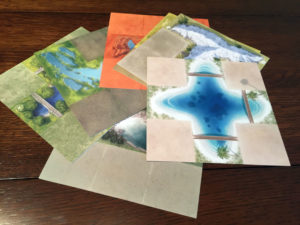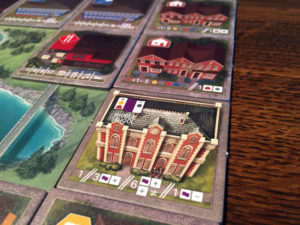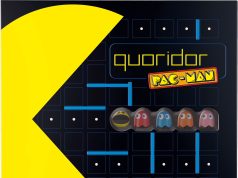 Between Two Cities is Stonemaier Games take on the pick-and-pass drafting genre. If you haven’t played it before, you can read out our full review of Between Two Cities here. But suffice to say, I found it an enjoyable game that also worked really well as a gateway game.
Between Two Cities is Stonemaier Games take on the pick-and-pass drafting genre. If you haven’t played it before, you can read out our full review of Between Two Cities here. But suffice to say, I found it an enjoyable game that also worked really well as a gateway game.
Recently, game designers Matthew O’Malley and Ben Rosset went back to drafting table and emerged with the Capitals expansion for Between Two Cities. Capitals adds three new modules that easily slide into your games of Between Two Cities. But I’m sure what you really want to know is if this expansion is worth adding to your collection. Let’s find out.
Expansion Overview:
The Capitals expansion adds 3 new elements that, according to Stonemaier Games, are designed to all work together, so you should either play with all of them or none. That being said, you could probably mix and match if you wanted to. In addition to the three game play changes, the expansion also comes with some new city tokens.

Landscapes
The First new element Capitals adds are the landscape mats. These are mats with terrain and spaces on them that players have to work around as they build their city. Instead of being a 4×4 grid, players are now building a 5×5 grid, of which the landscape mat must be fully enclosed.
Civic Buildings
The new type of tile in the expansion is the Civic building. This tile scores by being next to its preferred tile type (of which it will have 2), and by not being adjacent to the tile is doesn’t like.
One point I wanted to mention with the Civic tiles is that the icons for the preferred/non-preferred tile are way too small. From across the table, it can be a bit hard to see the icon shapes/colors on the tile. Most of the time, we had to pick up a tile to double check what it wanted to be next to. I wish they would have made those icons way bigger.
Districts
Districts in your city are made up from having contiguous areas of two specific tile types. Each of these will be randomized at the start of the game, with the 7th tile type not scoring as a district. The city with the largest district (with points for 2nd place as well) of each type will earn bonus points at the end of the game.

Game Experience With the Expansion:
If you read my review of the base game of Between Two Cities, you’ll recall that one of my complaints was that it could use a bit more variety. Games began to feel pretty similar after repeated plays. Well it’s safe to say that designers O’Malley and Rosset have addressed those concerns as the Capitals expansion definitely adds a nice bit of spice to the game play.

My favorite of which has to be the landscape mats. I really liked these as they not only added a challenge at the start of the game (how to work it into your city), but they look really nice once they are part of a completed city. Sure, most people care more about game play than looks, but one of the reasons I love tile laying games is the sense of accomplishment you get at the end. I feel like I’ve created something and the landscape mats went a long way towards reinforcing that feeling.
Interestingly though, the landscape mats were actually a little polarizing in our group. Some of us absolutely loved the added challenge the brought to the game, while others hated them. I’ll get more onto that in a minute.
My other issue with the base game was the lack of negative tiles. I really wanted to have more tiles that didn’t only score positively. Much like the Houses and factories, I liked how tiles had some restrictions on where they wanted to be. The civic buildings, while not going full on negative, at least added more interaction between the tiles, which I liked.
Iconography issues aside, the civic buildings feel unique and I liked how I had to plan my choices around getting two of the good tiles while avoiding the bad. To be honest, it wasn’t really hard to avoid the negative tiles, much like with the house/factory placements. It was definitely more of a challenge to get both sets of positive tiles in place.

Finally, there are the districts. The best thing they do is add some uncertainty to the end game. It’s pretty easy to look around the table and see who has large rows of shops, or many blue buildings and is going to be scoring booku points. Yet the districts are more abstract and it’s really hard to tell who’s in the lead for each without stopping to count. This was a nice way to add a bit of mystery to who’s really winning.
However I did find that the points awards for districts didn’t really seem worth focusing on (9 points on the high end) as a strategy. I found it more useful in the endgame to use a tile I normally wouldn’t take. I might have 4 shops in a row and know a 5th wouldn’t do me much good, but if I can add it to the shop district, it’s now worth taking.
Final Thoughts:
Between Two Cities: Capitals has a lot of good things going for it. It adds some nice variety to the game and the new elements all work well together. However, I don’t think it’s going to be for everyone. Whether it’s going to be for you entirely depends on what you want out of Between Two Cities.
In my original review, I said that Between Two Cities is a great gateway game. It is easy to teach and quick to play. Yet I think that the Capitals expansion takes Between Two Cities out of the gateway realm. As I mentioned above, some players didn’t like the added complexity of the landscape mats, and explaining how the districts works isn’t wholly intuitive, especially to someone who has never played.
So the bottom line is not everyone is going to need the Capitals expansion. If you like the simplicity of Between Two Cities and how easy it is to get to the table, then you should probable give Capitals a pass. Yet if you are like me and were looking for just a little bit more meat on the bone, than Between Two Cities: Capitals should be must by. It really helps take the game play up another level and might even change your mind about the original game if you thought it was a bit too light.
 Hits:
Hits:
• 3 unique new elements add variety
• Landscape mats increase the challenge and look great
• Districts adds some mystery to final scoring
Misses:
• Icons on the civic buildings are too small
• Added challenge can take it out of the gateway game realm





















